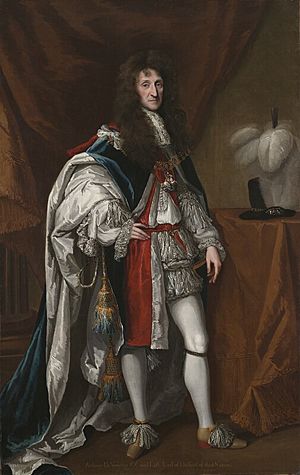Aubrey de Vere, 20th Earl of Oxford facts for kids
Quick facts for kids
The Earl of Oxford
|
|
|---|---|

Portrait by Godfrey Kneller
|
|
| Born | 28 February 1627 England
|
| Died | 12 March 1703 (aged 76) England
|
| Spouse(s) | Anne Bayning |
| Children | 5, including Diana |
| Parents |
|
Aubrey de Vere, 20th Earl of Oxford (born February 28, 1627 – died March 12, 1703) was an English nobleman and soldier. He held the important title of Earl of Oxford. He fought for the King's side, known as the Royalists, during the English Civil War. He was also a Knight of the Garter and a member of the Privy Council.
Aubrey de Vere's Early Life and Military Career
Aubrey de Vere was the son of Robert de Vere, 19th Earl of Oxford. His mother was Beatrix van Hemmend. When he was only six years old, his father was badly wounded in a battle in 1632. This happened during the Capture of Maastricht.
Education and First Steps in the Army
After his father's death, Aubrey was educated in Friesland, which is in the Netherlands. Later, he joined the English Regiment of Foot. He served with the Dutch army in Europe.
Returning to England and Supporting the King
Aubrey stayed in Holland during the English Civil War. But in 1651, he came back to England. He was a strong supporter of the King. He got involved in several secret plans to help the King. He was even put in the Tower of London. This was because he was accused of plotting against Oliver Cromwell, who was leading England at the time. He was held without a trial.
After being released, he joined a rebellion in 1659. This uprising was led by Sir George Booth. It was against the government of Richard Cromwell.
Helping King Charles II Return
In May 1660, Aubrey de Vere and five other noblemen went to The Hague. They asked for King Charles II to return to England. This event is known as the Restoration. Aubrey hoped to get a very important job, but he didn't. Instead, he was offered the job of Colonel of the Royal Horse Guards.
New Honors and Titles
Aubrey was a favorite of the King's friend, Barbara Villiers, Duchess of Cleveland. He was made Lord Lieutenant of Essex. This meant he was the King's main representative in that area. He also became a Knight of the Garter. This is a very old and important honor in England.
Leading a Famous Regiment
From 1684 onwards, Aubrey de Vere raised a special army group. It was a regiment of horse soldiers. They were officially called the Royal Regiment of Horse. But people knew them as Oxford's Blues. This was because of the blue color of their uniforms. Aubrey was the colonel, or leader, of this regiment. Many Protestant volunteers joined this group. King Charles II wanted to make the army bigger.
A visitor from Tuscany, Prince Cosmo of Tuscany, saw Oxford's soldiers in 1668. He wrote about them. He said they were "excellently mounted." He also noted that the officers wore "a red sash with gold tassels."
Aubrey de Vere was part of the first Army Board meeting in 1670. This meeting was led by the King's brother, the Duke of York. The Duke of York later became King James II.
Standing Up for His Beliefs
As Lord Lieutenant of Essex, Aubrey was in charge of raising soldiers in the county. However, he refused King James II's order. The King wanted him to appoint Roman Catholics to public jobs. In February 1688, Aubrey told King James that he would support him against enemies. But he also said, "this is a matter of conscience and I cannot comply." Because of this, he lost his jobs.
Months later, he supported William of Orange. William came to England against King James II in the Glorious Revolution. Aubrey was given back his titles and his job as colonel of The Blues.
Aubrey de Vere's Family Life
Aubrey de Vere was married twice.
First Marriage
His first wife was Ann Bayning. She was the daughter of Paul Bayning, 2nd Viscount Bayning. Ann was very young when they married. She was buried in Westminster Abbey in 1659. They did not have any children together.
Second Marriage and Children
In 1672, Aubrey married Diana Kirke. She was the daughter of Anne Killigrew and George Kirke. They had five children together:
- Charles (Karl), who died as a baby.
- Charlotta, who was born in 1673. We don't have more information about her.
- Diana, born around 1679. She later became Diana Beauclerk, Duchess of St. Albans. She married Charles Beauclerk, 1st Duke of St Albans. He was another son of King Charles II.
- Mary, who never married.
- Henrietta, who also never married.
Aubrey de Vere passed away in 1703. He did not have any sons who could legally inherit his title. Because of this, the title of Earl of Oxford came to an end. It was one of the oldest titles in England. He was buried in Westminster Abbey.

